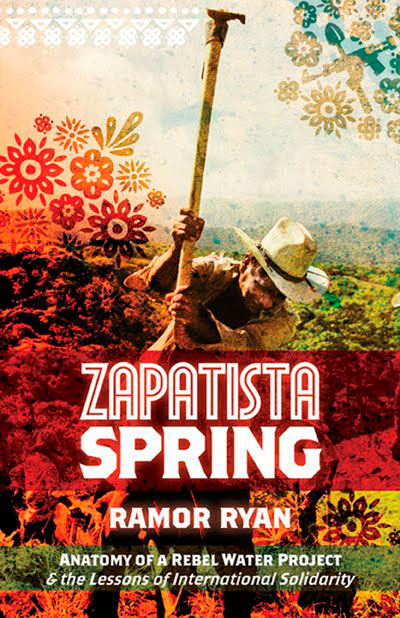Over 30 years of anarchist writing from Ireland listed under hundreds of topics
Review: Zapatista Spring
Date: Mon, 2011-10-17 14:24
 Editors’ Note: In this issue of the IAR we have the all too rare pleasure of reviewing a book by a fellow Irish anarchist. It’s Ramor Ryan’s Zapatista Spring, one of the most honest books yet published about the Zapatistas.
Editors’ Note: In this issue of the IAR we have the all too rare pleasure of reviewing a book by a fellow Irish anarchist. It’s Ramor Ryan’s Zapatista Spring, one of the most honest books yet published about the Zapatistas.
While Ramor Ryan’s “Clandestines” detailed the myriad adventures of a peripatetic revolutionary, his follow up book, “Zapatista Spring”, concerns itself more with the minutiae, and frequent tedium, of weeks spent in Chiapas demonstrating “practical solidarity”. In his own words, he is “attempting to portray the Zapatistas as they are at the grassroots, beyond the mythologizing of [Subcomandante] Marcos and the public face of the rebellion.”
However, it can also be seen as a companion piece to “Clandestines” in that his Spartan surroundings while there allow him time to reflect on the motivations behind his revolutionary activities, as well as those of other volunteers.
Initially Ryan visited Chiapas as part of the “accompaniment” strategy, whereby international activists immersed themselves in Zapatista communities, living and working with the peasants. This was “tactically successful throughout the late 90’, as the[ir] presence … might well have staved off the worst of the military excesses, serving as eyes and ears to monitor human rights in the conflict zone. However, in consolidating the rebel project of building autonomy [it] was lacking.” Hence the move towards “practical solidarity”, encompassing, amongst other things, water projects.
He and a number of other volunteers form a “water team” who help to build a basic water supply in a remote Zapatista village, Roberto Arenas. They comprise Ryan, Maria from America and Praxedis from Mexico City, which may as well be a different country as far as the villagers are concerned. There is no indication when this episode took placed although it is probably around 2002/3.
Contradictions
Contradictions abide for a committed anarchist. Deep-rooted patriarchy within the village is highlighted and challenged, within certain limits. While the gender based division of labour (men do the construction work, women the field and house work) remains, the women did finally get some input into the design of the water system to make it easier to fill their predestined roles. Anarchists must take on roles of authority, delegating manual work to the villagers (not very successfully in Ryan’s case!).
Ideology aside, there are other complications. Revolutionary village campesinos continuously enquire about the possibilities of work abroad. Racist, sexist truck drivers are hired to transport the vital equipment to rebel held territory. The “water team” must pass through neighbouring government held territory where the equally poverty stricken peasants remain PRI (the governing party) supporters. International vegetarian volunteers object to the shooting of wolves that threaten the villagers’ chickens and children. Communities sometimes switch sides depending on the opportunities that varying their allegiance can bring, with outlying Zapatista aligned villages sometimes having a somewhat adversarial relationship with their compatriots in bigger towns. Particularly instructive, in an Irish context, are some of the parallels with the ongoing Garda occupation of Erris in Mayo. Communities are bought off by state handouts and investments in much the same was as Shell have attempted to do.
A conversation between Ryan and Praxedis explores the rationale behind their presence in the area, as an act of solidarity with the base of the Zapatista movement, notwithstanding their devout religious beliefs, social conservatism and frequent nationalism. Whatever the conflicts between they (urbanised, socially liberal and atheistic) and their hosts, they ultimately conclude that, as anarchists, this is the “coalface of the struggle”. Ryan views himself as a Celtic Tiger refugee, seeking revolutionary possibilities, away from a place where “everything just seemed to be sucked up into the economic boom, and everybody became mesmerised by Ireland’s new wealth and capital and forgot about solidarity and collectively building communities based on hope and reciprocity.”
A Zapatista In Your Own Country
One of their EZLN guides suggests that the visiting activists “should be working in [their] own community, fomenting rebellion.” This line of thought seems to have become more widespread within the EZLN, resulting in their recent call for no international visitors to their area and they having broken almost all links with NGO’s. So, this “practical solidarity” strategy seems to have backfired somewhat with, in this instance, the villagers continually viewing the “water team” as some type of NGO despite our protagonist’s best efforts to explain otherwise. Ryan eventually concludes the divide between the internationals and the indigenous may perhaps be too great a one to bridge, they can always leave while the campesinos are stuck.
On a more micro level, anarchist activists will recognise the difficulties mentioned between competing tendencies described in Mexico City and the tensions between the activists themselves in Chiapas. In describing this and the sometimes strained relations with the campesinos, Ryan illustrates problems almost all activists will have encountered albeit perhaps in different contexts.
There are some problems with this work, the most obvious being the disclaimer on the insert that “while this book is based on true events, some characters and scenes have been fictionalised”. So what is true and false? Are characters merely introduced as a device to illustrate a particular problem? For example, when a Mara gang member from Honduras stumbles into Roberto Arenas having lost his way on the long trek north to the US, did this actually happen or does it merely allow Ryan to spin a parable on the harshness of urban existence across Central America?
Given the professed aim of the book, it detracts significantly from the finished product if the reader cannot be sure if it portrays the Zapatista base in any way accurately. There are a number of typos and there is the occasional resort to cliché, the children are rarely anything other than sweet, the locals are stoic and the countryside bucolic.
This is not a primer in Zapatismo and, as someone not overly familiar with the Zapatista movement and revolution, I didn’t gain any particular overarching insight into the situation in Chiapas. But, first and foremost, “Zapatista Spring” is a story, a simple yet engaging one, in no small part due to Ryan’s succinct prose and easy humour. He illustrates some of his thoughts by reference to themes explored in Joseph Conrad’s “Heart of Darkness” and Albert Camus’s “Myth of Sisyphus”, a device that works well in clarifying his position on his role in Chiapas. The author also doesn’t gloss over his own failings; he loses his temper on occasion and can be anti-social.
While the overall premise may appear slight, the complications involved in transporting equipment through army controls and difficulties in relations with the locals make for a page-turner. Finally there is a twist in the tail that ties everything together in a peculiarly satisfying way.
The Zapatistas have recently re-emerged in public last May after a five-year hiatus, participating en masse in a rally in San Cristobal pushing for a political solution to the narco-trafficking problem in Mexico rather than the infinite war pursued by the government. Ryan’s ultimate conclusion is that they are a force for good and thus this can only be a positive step.
This article is from Irish Anarchist Review, Issue 4, October 2011


